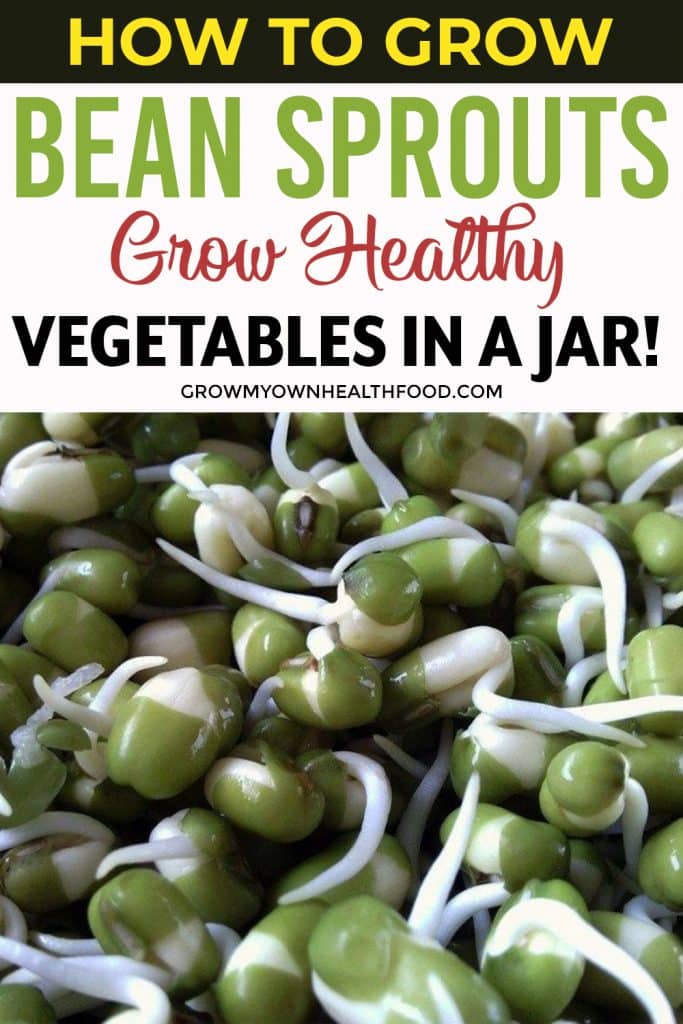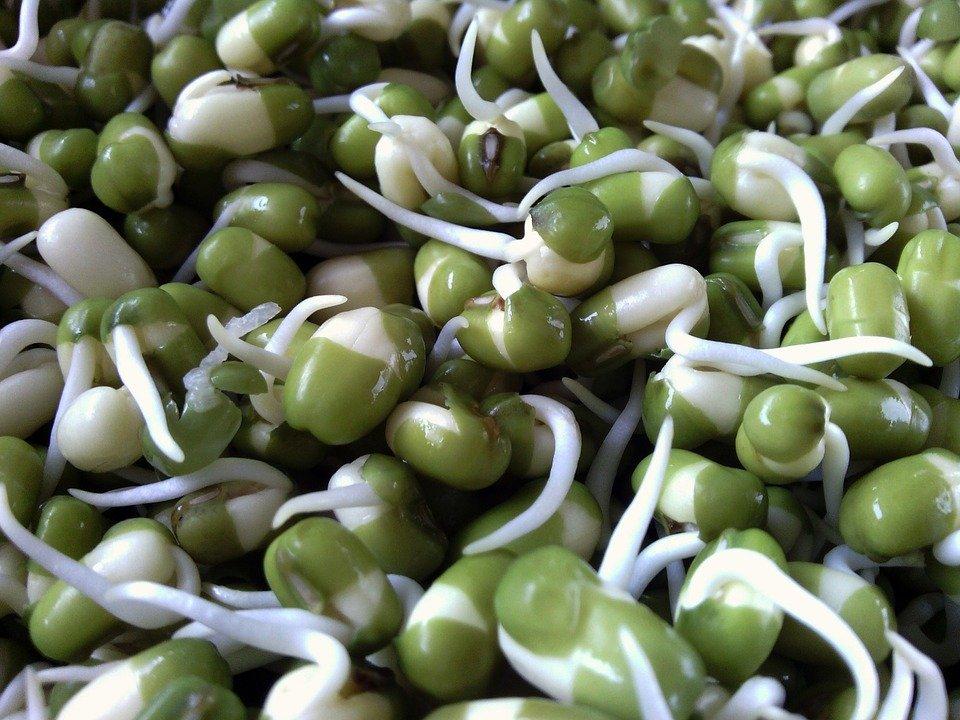Ever tried bean sprouts? These healthy, crunchy, and delicious vegetables are easy to grow at home and are ready to be tossed in salads, stir-fries, and pasta in as little as 4 days? Continue reading to discover how to grow mung bean sprouts right on your kitchen counter.
If you love healthy vegetables, but don’t have a large growing space in your yard, growing bean sprouts indoors is the perfect solution! With just a little space on your kitchen counter, you can grow loads of bean sprouts throughout the year for a continuous supply of fresh, homegrown vegetables. Though it’s called ‘growing’, it won’t require soil, fertilizers, or any of that mess that comes with gardening. You won’t need anything besides a jar and water!
What Are Bean Sprouts?
Ever seen those tiny sprouted mung beans tied in elastic bands, packed in plastic bags being sold in grocery stores? You’ll often find the label “Product Of China” on these little packages. Those are mung bean sprouts. Retailers make money out of the fact that they look like an exotic Chinese vegetable that not many customers know about. If they knew what it was or how easy it is to grow them at home, they wouldn’t ever buy it in the first place!
Mung bean sprouts are simply mung beans that have sprouted. Lentils, alfalfa, adzuki beans, and chickpeas can also be sprouted to use as a vegetable. While some seeds take longer to germinate, mung bean sprouts are one of the easiest and fastest to grow.
Health Benefits of Bean Sprouts
Mung bean sprouts can be consumed raw or lightly cooked. No matter how you serve them, they’re packed with vitamin C and A, proteins, iron, and fibers. They’re especially good for you if you suffer from high blood pressure. Besides, they help with digestion, improve your eye health, and even prevent cancer. So there are plenty of reasons for growing bean sprouts. Overall, these tiny greens are a nutritious addition to your regular diet.
How To Grow Mung Bean Sprouts
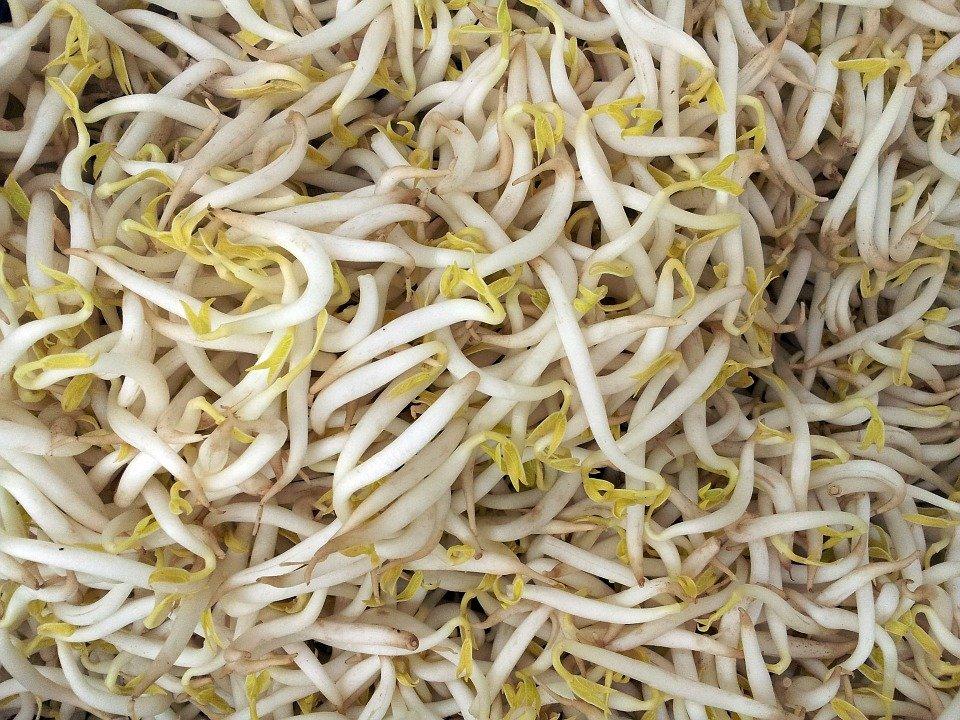
Now that you know what bean sprouts really are and all the exciting benefits they bring, you’ll definitely want to know how to grow bean sprouts in a jar! Yes, you read that right! You don’t need a clay pot or soil to grow your sprouts! You’ll just need a jar and water, and you probably already have loads of empty jars in your kitchen. If you also have mung beans in your pantry, you won’t need to buy anything.
What You Need to Grow Bean Sprouts Indoors
You might already know this from what you’ve read above, but just as a reminder, here’s what you’ll need to start the project:
Mung beans
You don’t need any special variety for sprouting. The regular whole mung beans you find at grocery stores will work great. Just make sure they’re not sprayed with chemicals that prevent sprouting. For the healthiest vegetables, choose organic beans because they’re free from all kinds of harmful chemicals.
Bean Sprout Caution!
Beware of contaminated seeds as they can cause illness. It’s very important that you choose untreated mung beans from a reliable food store. The ones at the gardening centers are great for growing bean plants, but they’re not recommended for sprouting since they may have been treated with chemicals.
Jar
- 2-Regular mouth glass preserving mason jars. 2-Regular mouth lids. 2-Regular mouth bands.
- Ideal for sliced fruits and vegetables, pickles, tomato-based juices, and sauces.
- These jars are BPA-free
- New and improved sure tight lids
- Helps keep canned food sealed now for up to 18-months
Prices pulled from the Amazon Product Advertising API on:
Product prices and availability are accurate as of the date/time indicated and are subject to change. Any price and availability information displayed on [relevant Amazon Site(s), as applicable] at the time of purchase will apply to the purchase of this product.
Choose a regular mason jar with a wide mouth to easily manage your sprouted mung beans. Wash it thoroughly with clean water to remove any contamination, including soap.
Water
Cold, clean water will work for growing bean sprouts. Regular tap water is okay for sprouting beans, as long as it’s cool.
Seed Sprouting Screen lid or Cheesecloth and Rubber Band
- Affordable Combination 4-Piece Set: 4 x Stainless Steel Mason Jar Rings, 4 x Matching Mesh Inserts.
- High-quality Materials: The stainless steel sprouting lid kit is made of 316 stainless steel, which is not easy to corrode and rust. BPA-free, non-toxic, odorless, durable and not deformed.
- Multi-mesh Design: Exquisite meshes make your washing and draining process easy and free, and provide excellent airflow. It can give your bean sprouts the best sprouting experience.
- Multi-function: The sprouting lid is not only used for germination, but also can be used as a screening cover to filter smaller seeds or loose leaf tea.Or make a filter cover for seasoning powder, such as chili powder, black pepper and so on.
- Applicable Jar/Can: Suitable for growing broccoli seeds, mung beans, nuts, alfalfa seeds, grains and more sprouted seeds in wide-mouth mason jars, wide mouth Ball, Kerr and Bernadine.Or the bottle mouth is 3.35 inch/85mm bottle. You can easily grow a small amount of healthy and delicious sprouts in the kitchen and tab
Prices pulled from the Amazon Product Advertising API on:
Product prices and availability are accurate as of the date/time indicated and are subject to change. Any price and availability information displayed on [relevant Amazon Site(s), as applicable] at the time of purchase will apply to the purchase of this product.
This is for covering the mason jar for sprouting the beans. If you don’t want to purchase specialized seed sprouting lids, a simple cheesecloth will do the job just fine!
Growing Bean Sprouts Steps To Follow
Now that you have all your material in place, it’s time to learn how to grow bean sprouts in a jar! The procedure is surprisingly simple, but if this is your first time, it will help if you follow the guidelines mentioned below to grow world-class bean sprouts at home!
Prepare the mung beans
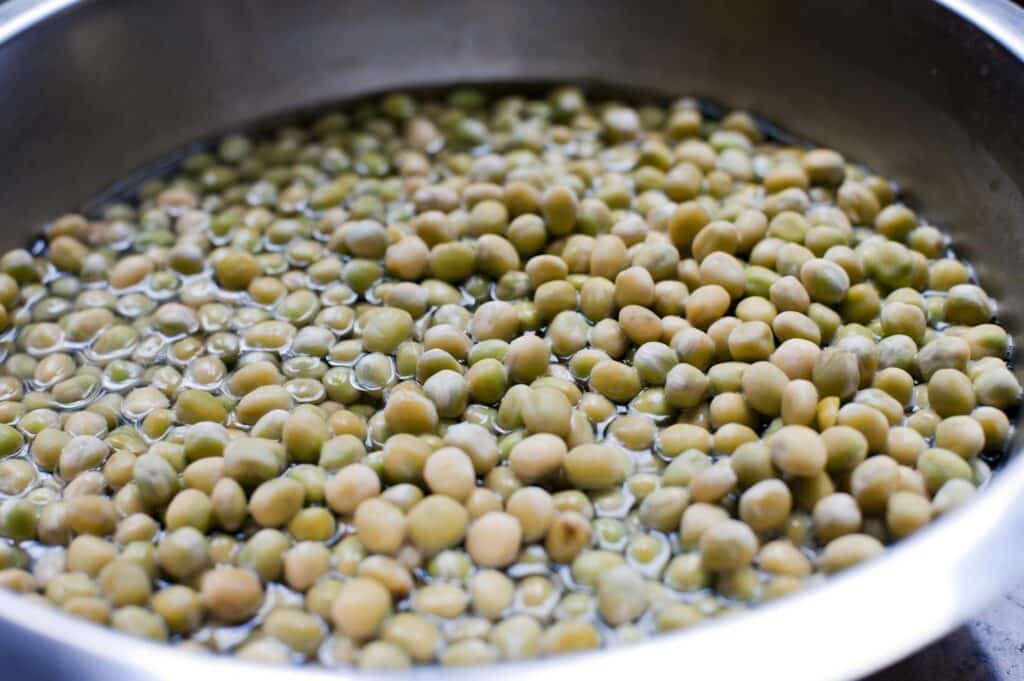
Before sprouting, you need to prepare the beans. Remove any stones or other foreign objects. Also, throw away all damaged beans. Once you have all the good mung beans to sprout, wash them thoroughly to get rid of any contaminations.
Fill the jar
Fill the jar to half its capacity with cold water.
Add beans
For a one-quart mason jar, you can add two tablespoons of mung bean seeds for sprouting. Adjust the quantity according to the size you have. Even if you choose other varieties of beans for sprouting, don’t fill them to more than 1/4th of the jar since they’ll also take some space to expand.
Cover the jar
Either place a sprouting lid over the jar or cover it with a cheesecloth. If you’re using cheesecloth, you’ll need to secure it in place with a rubber band. You can also fix a mesh screen onto the outer ring of a mason jar’s lid to create your own sprouting lid!
Soak overnight
Leave the beans to soak 8 to 12 hours or overnight and drain out all the water through the mesh lid in the morning. Rinse it again with clean water and drain through the lid.
Rest the jars
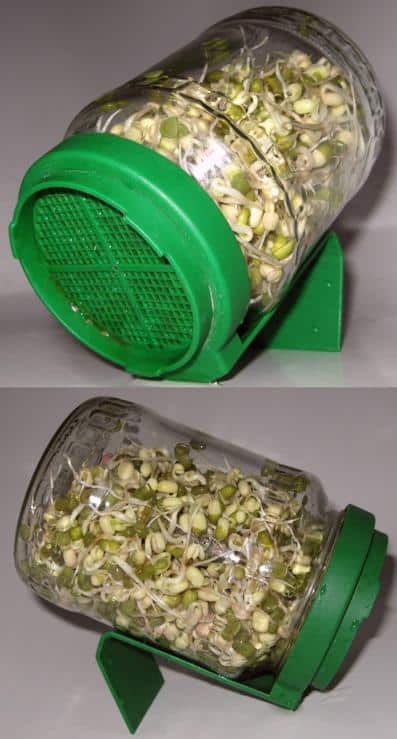
Place them at an angle over a cooling rack, the side with the lid facing downwards. This will allow all the excess moisture to drain out through the top. Placing it at an angle is important because you need to allow air circulation through the lid. Keep this arrangement in a location away from sunlight.
Rinse and drain
For the next 2 to 4 days, you’ll need to rinse and drain the beans just as you did in step 5. Make sure you drain out the water completely each time you rinse and return it to the location away from sunlight, where you’ll rest it tilted over the cooling rack. If you see any sprouts showing signs of spoiling, remove and discard them right away so they won’t damage the rest of the lot.
If you’re growing bean sprouts using a different variety other than mung beans, the process can take anywhere between 2 to 6 days.
Ready to eat
Once they reach the desired size – which is usually around ½ inches for mung beans, but it’s a matter of preference – remove the bean sprouts from the jar. Rinse them well and use them right away. If you don’t plan on eating it all up fresh, refrigerate them in a dry container and use them within a week.
How To Eat Bean Sprouts

Now that you know all the key considerations on how to grow mung bean sprouts, you should also know how to eat them for the best flavors and nutrition. Bean sprouts are delicate vegetables, much like herbs. They’re usually eaten raw or after some light cooking. Mung bean sprouts can be added during the last two minutes of cooking. Adzuki beans and chickpeas sprouts will need to be cooked for around 15 minutes.
Safety Considerations for Bean Sprouts
There are some safety considerations regarding bean sprouts. While they’re super healthy when prepared and stored the right way, they can cause food-borne illnesses if stored in a warm and humid environment. This is because the combination of warmth and humidity presents the perfect home for bacteria. Always store them dry in the refrigerator and use them within a week.
If you’re pregnant, old, or a child, avoid consuming raw bean sprouts. Consuming them properly cooked in stir-fries or other recipes is perfectly safe for you.
How Long Will Cooked Bean Sprouts Stay Good
If you’ve cooked them in a recipe, store any leftovers in the fridge and consume them within the next 3 to 4 days for maximum freshness and flavor.
Bean Sprout Recipes

You already know how to grow bean sprouts in a jar. Are you looking for some recipe ideas next? You can toss a bunch of these to your salad for a crunchy, fresh addition. You can also try out the following recipes:
- Sauteed Chinese Mung Bean Sprouts
- Bean Sprout Soup
- Kongnamul Bap (Bean Sprout Rice Bowl)
- Sookju Namul (Korean Bean Sprout Salad)
Helpful Products For Growing Bean Sprouts
1. WANBAO 304 Stainless Steel Sprouting Lids
- Each package include 3 stainless steel rust resistant sprouting insert lids(2 4/5 in (72 mm) inner) and 4 stainless steel bands (3 3/8 in (86 mm) outer diameter) perfect for wide mouth Mason jars, canning jars. The indentations of the sprouting lids rim make it easy to loosen the sprouting jar lids.
- Seeds Sprouting Lids are made of 100% food grade 304 stainless steel, which is rust resistant and last longer than the ordinary one. With these Three sprouting lids, mesh lids for Mason jars, perfect for making organic sprouts in your home or kitchen and supply fresh sprouting constantly.
- A perfect size mesh screen allows easy draining and empty the water from the Mason jars but no loss of seeds. This excellent jar sprouting kit keeps the ventilation and supply the oxygen they need, making germination easier! It can be boiled and sterilized and fully dishwasher safe.
- The sprout strainer lids fits wide mouth Ball pint (16 oz) jars, quart (32 oz) jars or half gallon (64 oz) jars. All the screens have the same size mesh that work fine from the smallest sprouting seeds to the largest one. Jars and seeds not included.
- Fast Delivery: All WANBAO Product are Fulfilled by Amazon with 100% Guarantee Fast Shipment and Good Customer Servi
Prices pulled from the Amazon Product Advertising API on:
Product prices and availability are accurate as of the date/time indicated and are subject to change. Any price and availability information displayed on [relevant Amazon Site(s), as applicable] at the time of purchase will apply to the purchase of this product.
2. SofaRay Plastic Sprouting Jar Lid with Stand
- Almost Everything To Get Started - Package includes 2 X glass Jars, 2 X 316 stainless steel sprouting lids, 1 X ceramics drip tray and 1 X 304 stainless steel stand - makes it a perfect gift idea.
- Lasting Durability - Our sprouting lids are made from premium food safe 316 surgical stainless steel and stand is 304 stainless steel - which offers superior durability and protection against rust and corrosion.
- Food Safe Material - The thick soda-lime glass is lead free and non-porous - makes the sprouting Jars much durable, safe to use and clean. The quart size and wide mouth provide an ample room to grow sprouts and easily acce
Prices pulled from the Amazon Product Advertising API on:
Product prices and availability are accurate as of the date/time indicated and are subject to change. Any price and availability information displayed on [relevant Amazon Site(s), as applicable] at the time of purchase will apply to the purchase of this product.
3. Masontops Bean Screen
- ONE SIZE FITS ALL: Masontops is the name to trust for Mason jar accessories. The Bean Screens patented design designed to fit all Wide mouth Ball, Kerr and Bernardin mason jars, creating the perfect environment for growing super nutritious sprouts.
- GROWS ALL KINDS OF SPROUTS: The Bean Screen grows all types of densely nutritious sprouts, including broccoli, alfalfa, mustard, mung bean and more. Sprouts are loaded with vitamins, fibre and iron. Turn your wide mouth mason jars into sprout machines!
- MAXIMIZE AIRFLOW AND DRAINAGE: Bean Screens have pegs enabling your jas to stand on end for complete drainage, inhibiting spoilage. The faceted sides stop the jar from rolling and stabilize the growing environment as the jar rests on its side.
- INVERTED SPOUT FOR EASY RINSING: Bean Screens have an inverted spout, so rinsing is a cinch. The screens on other lids have to be unscrewed and removed, otherwise theres a lot of splashing. Been Screens never have to be removed at any stage of the sprouting process.
- MADE FROM BPA-FREE PLASTIC: The Bean Screen is made of BPA-free plastic with silicone sealing gaskets, so you can be sure its totally food safe. Youll enjoy growing your own superfoods at home and know theyre as healthy as can
Prices pulled from the Amazon Product Advertising API on:
Product prices and availability are accurate as of the date/time indicated and are subject to change. Any price and availability information displayed on [relevant Amazon Site(s), as applicable] at the time of purchase will apply to the purchase of this product.
4. Esdabem Sprout Growing Kit
- 🌱Sprouting kit: include 2pcs 1050ml (36 oz) Wide Mouth Mason Jars and 2 plastic sprouting jar lids(with support frame and unique porous concave nozzle design).perfectly combine into two sets of seed germination devices, no need to purchase additional sprouting jar, available to use it immediately. Easy to sprout seeds in as little as 3 to 5 days. Enjoy fresh organic sprouts in salads, sandwiches, soups, stir-fry, wraps
- 🌱 Innovative design: We have passed hundreds of experiments and practical verifications. Carried out a new and innovative design. We separated the lid. This makes our kits easier to clean and greatly improves the utilization of threaded rings. The unique porous concave nozzle design allows your bean sprouts to get excellent flushing, drainage and air circulation-ensuring the best results for the germination experience
- 🌱 Absolute money saving: the innovative tripod design can save you a lot of money. Each of our families has bowls, plates, butterflies and other household utensils. Just turn the germination kit upside down on the plate, you can easily filter the excess water. No need to spend extra money to buy new germination brackets and trays. Even if you put the kit in an absorbent towel, it will ferment perfectly
- 🌱Simple and efficient: When we turn the bottle upside down, unique wide tripod design can easily filter out the excess water. Keep fresh air circulation to ensure a healthy growth environment for the nutritional buds. The design of the lid makes it easier to tighten and remove the sprouting cap. The 36-ounce large-capacity jar will give you enough bean sprouts. The wide opening can easily reach the bottom of the jar, so it can be easily and thoroughly cleaned with a sponge
- 🌱HEALTHY AND FUN - Sprouts are highly nutritious. Sprouts provide enzymes, chlorophyll, and nutrients that very few vegetables provide. Take steps towards a healthier lifestyle by growing and consuming your own sprouts. Growing sprouts can be enjoyed by the entire family. Children can get involved in growing and learning all about them t
Prices pulled from the Amazon Product Advertising API on:
Product prices and availability are accurate as of the date/time indicated and are subject to change. Any price and availability information displayed on [relevant Amazon Site(s), as applicable] at the time of purchase will apply to the purchase of this product.
Conclusion
So now you know how to grow mung bean sprouts at home. When it barely takes any time to grow the perfect bean sprouts right on your kitchen counter, who would want to buy those at the supermarket? After all, you can never be sure if they were sprouted and packaged just recently or days ago. Just like all other fresh vegetables, you’ll get the healthiest, crunchiest, and tastiest results when you grow them with your own hands!
